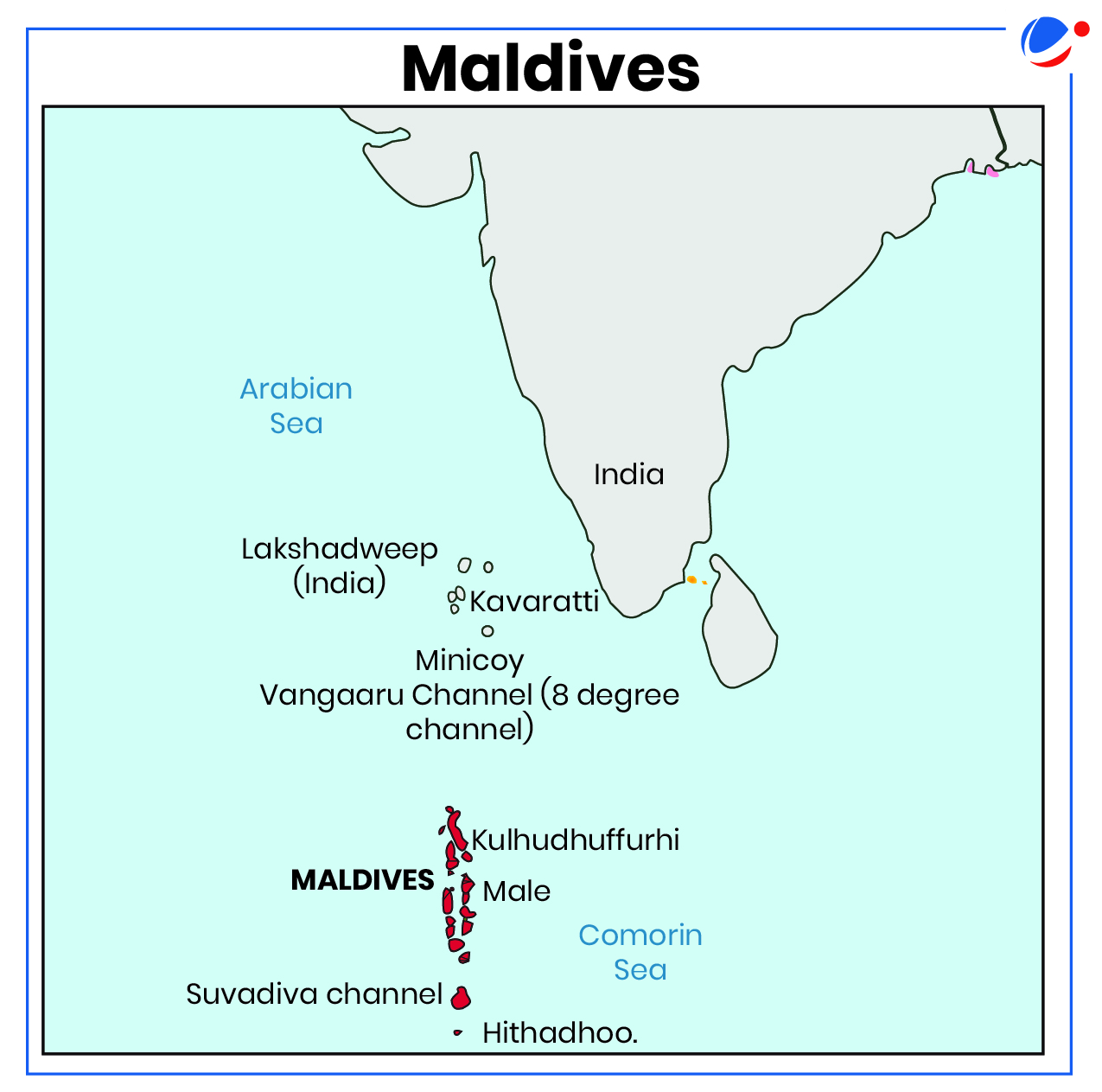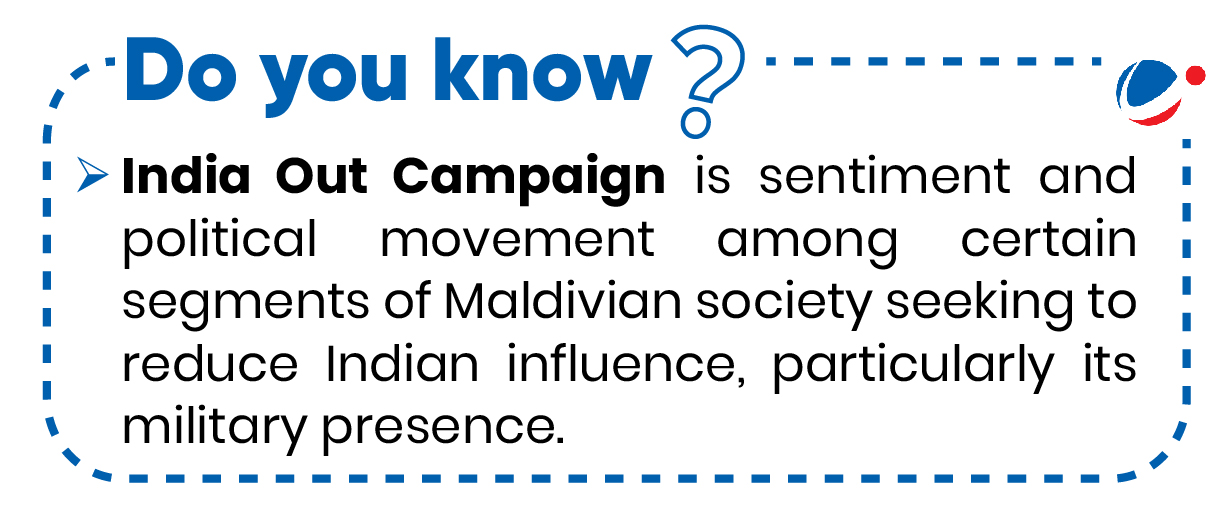Why in the News?
The president of Maldives made his maiden bilateral state visit to India after winning the presidential elections last year.

Key outcomes of the visit
- Both sides announced adoption of vision for "Comprehensive Economic and Maritime Security Partnership" which encompasses:
- Development Cooperation: Agreed to support timely completion of Greater Male Connectivity Project, etc.
- Trade and economic cooperation: Initiate discussions on Bilateral Free Trade Agreement; both sides agreed to operationalize settlement of trade transactions in local currencies to reduce dependency on foreign currencies etc.
- Digital and financial initiatives: Launch of RuPay card in Maldives will enhance ease of payments for Indian tourists visiting Maldives etc.
- Health cooperation: To work towards recognition of Indian pharmacopoeia by Government of Maldives, followed by establishment of India-Maldives Jan Aushadhi Kendras across Maldives etc.
- Both sides signed Currency Swap Agreement (CSA) to help Maldives in managing their foreign exchange reserves.
- It was signed under the SAARC Currency Swap Framework 2024-27.
- CSA is a contract under which two counterparties agree to exchange two currencies at a set rate and then to re-exchange those currencies at an agreed upon rate at a fixed date in future.
- Inauguration of runway at the Hanimadhoo International Airport and India's support for the development of a new commercial port in Thilafushi.
Significance of Maldives for India
- Geopolitical: Maldives is one of the cornerstones of India's NFP (Neighbourhood First policy) and SAGAR (Security and Growth for All in the Region) due to its location.
- Strategic:
- Maldives is geographically positioned like a 'toll gate' between western Indian Ocean chokepoints (Gulf of Aden and Strait of Hormuz), and eastern Indian Ocean chokepoint of Strait of Malacca.
- Situated along key shipping lanes in the Indian Ocean, Maldives is central to India's interests in safeguarding freedom of navigation, regional security and stability.
- Geo-economics: Maldives is located along the major commercial Sea lines of communication (SLOC).
- 50% of India's external trade and 80% of India's energy imports transit through these SLOCs in the vicinity of Maldives. Also, India emerged as Maldives' largest trade partner in 2023 touching almost $1 billion.
- Security: A strong relationship with Maldives will enable India to counter China's ambitious 'String of Pearls' in the IOR.
- Counter terrorism and piracy: For India, Maldives is the first line of defence against terrorism, piracy on the high seas, drug trafficking etc., in the Indian Ocean.
- Diaspora and Tourism: Indian expatriates makes up a large part of the workforce in the Maldives, especially in sectors like healthcare and education. Also, it is a popular tourist destination for Indians, which benefits both economies.
Challenges in the bilateral relationship

- China's strategic footprints: China's rising footprints in the Maldives through the 'Belt and Road Initiative' (BRI), 'String of Pearls' construct, investment in Maldivian infrastructures has raised concerns for India.
- E.g., construction of the Sinamale Bridge, pact for military assistance to Maldives, etc.
- Radicalisation: Increase in radical Islamist fundamentalists in Maldives, including Pakistan backed jihadi terror groups, Islamic State (IS) etc.
- India's concern: These terrorist organisations may use Maldives as a launch pad for attacks on India and Indian assets.
- Anti-India sentiments: Growing anti-India sentiments under the current Maldivian regime, demanding withdrawal of Indian military troops and helicopters, halting Indian infrastructural developments, India-out campaign, etc.
- Lack of transparency and misunderstanding: Raising of objections by local Maldivian media in the agreements signed between the previous regime and India.
- E.g. Indian grant-in-aid UTF (Uthuru Thila Falhu - Island) Harbour project was speculated by Maldivian media that it would be turned into an Indian naval base instead of Maldivian coastguard harbour and dockyard.
Way ahead to strengthen the bilateral relationship
- Cooperation and projects: India needs to speed up cooperation and timely deliver infrastructure projects, e.g., Great Male Connectivity Project, to offer alternatives to Chinese projects.
- Enhanced financial aid: India's economic outreach is essential to help Maldives break free of China's 'debt-for-leverage' model of diplomacy.
- Security cooperation: Both countries need to strengthen cooperation in areas of anti-terrorism, counter-radicalization through measures like joint security exercises, intelligence sharing etc.
- Soft diplomacy and perception management: India needs to engage its cultural aspects like diaspora, films, music and people-to-people exchanges to counter anti-India sentiments, build confidence and earn the good will of the Maldivian people.
- Gujral doctrine: India needs to adhere to the principles of Gujral doctrine that guide the conduct of India's foreign relations with its immediate neighbours.






